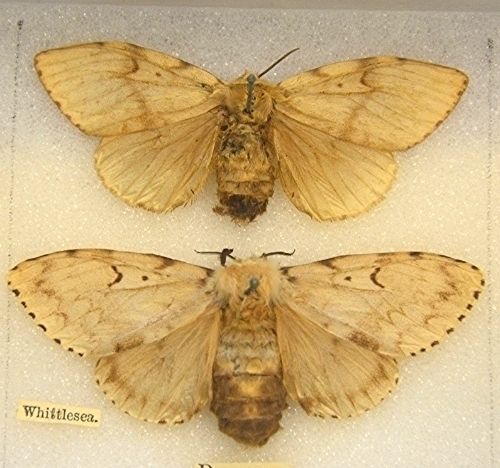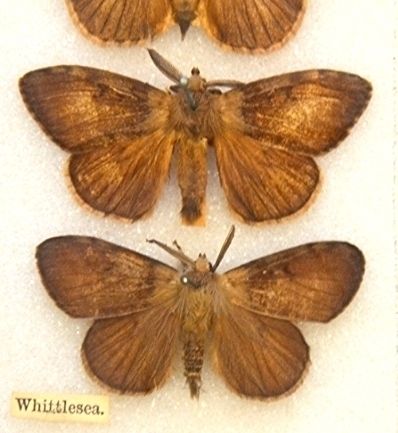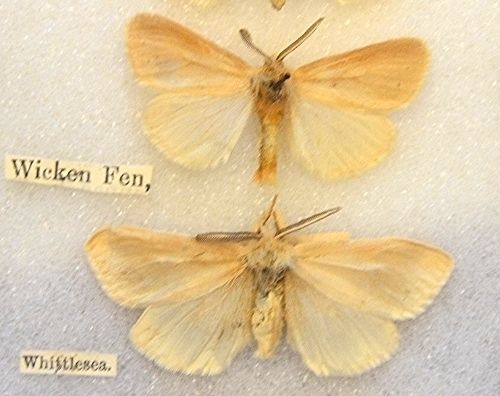|
|
Post by nomad on Feb 26, 2015 18:55:02 GMT
Perhaps the most exciting British butterfly to encounter in the wild is the endemic subspecies of Swallowtail [ Papilio machaon britannicus ]. This butterfly is confined to the Norfolk Broads of East Anglia in England. The Broads are large areas of open water, which were created by medieval peat excavations on large areas of low lying marshland and are one of the best wildlife sites in the U.K. The Hickling Broad Nature reserve is a good place to see Swallowtail butterflies . However, the reserve is thronged with visitors that are channelled along raised wooden broadwalks through the reedbeds. I had briefly observed Swallowtails flying strongly across the reedbeds, but then the cloud and rain had closed in. On the second day it was a relief to have some peace and quiet in a less well known area of Hickling broad and it was a beautiful morning, when after the night of heavy rain, the early summer greens sparkled in the sunshine. I began by walking along a footpath which followed a deep water filled dyke on the edge of the reedbeds. I was alone, except for a few hidden reed-cutters working in the marshes. Their work was very beneficial to our Swallowtail, creating open habitat for its sole foodplant Milk- Parsley [ Peucedanum palustre ]. I walked on and soon the reed-cutters machine faded into the background. I rested on a boat landing stage and sipped tea from a flask I always carried on my butterfly expeditions. Now the only sounds were buzzing insects and I watched several species of dragonfly hunting along the dykes and a dark form of a female Marsh Harrier floating nearby just above the reeds looking for its prey, small birds nesting in the reeds. I observed a few P. machaon on the opposite side of the dyke, but they soon disappeared from view. Now the herbage along-side the footpath looked more interesting and as I came to a patch of Red Campion [ Silene dioica ] , a large beautiful female Swallowtail appeared just above my head and descended to feed on the pink flowers. I found that the Swallowtail butterfly was not easy to photograph, while sipping nectar they continue to flutter their wings to hold their heavy bodies above the delicate flowers.  A female Swallowtail lands in the rain laden grass.  Hicking Broad where P. machaon britannicus flies. Nearby was an even bigger clump of a favourite nectar source, the pink flowers of the Ragged-Robin [ Lychnis flos-cuculi ] and here I waited, camera ready. Within a short time a number of smaller male Swallowtails came to feed and to have several of these fine butterflies floating and feeding around me was a magical experience. Later nearby, I found a fine fresh female resting in the dew laden grass and then high on a Hogweed [ Heracleum sphodylium] another male came to feed and I obtained a very nice photograph. I was very pleased with the images I managed to obtain and looking at them, I remember a wonderful day spent with the British Swallowtail and they bring a yearning for that far off fenland with its lovely and unique butterfly. So this year I must return.  A male visits the tall umbellifer ' Hogweed.  A Swallowtail visits, the lovely Yellow Iris - Iris pseudacorus.   The fen sparkled after a night of heavy rain, habitat of the British Swallowtail.  A freshly emerged female rests in the reeds.  Visiting the delicate pink, Ragged Robin.  The pink Red Campion is a good nectar source.  Resting Male.  My first Broad-bordered bee Hawk-Moth - Hemaris fuciformis was seen in a Hickling Broad cottage garden.  A Four-spotted Chaser -Libellula quadrimaculata, a common Dragonfly.  The tiny Lizard -Zootoca vivipara was common in the fens.  The elegant and rare royal fern, Osmunda regalis growing in the fens.  Hickling Broad.  Searching for Swallowtails |
|
jensb
Junior Aurelian
 
Posts: 50
Country: Netherlands
|
Post by jensb on Feb 26, 2015 19:02:26 GMT
Nice story thnx for sharing.
Greets jens
|
|
|
|
Post by nomad on Feb 28, 2015 12:41:36 GMT
One of the things I find fascinating about the British Papilio machaon subspecies is its restriction to its fenland habitat. Once more widespread in the marshes of England, drainage has seen the insect confined to the Norfolk Broads. Subspecies gorganus seems to occur in most habitats in Europe and has turned up here as an immigrant and has bred in recent years. We will have to wait to see if gorganus is able to establish in Southern England. In spite of all the newspaper reports and excitement of breeding continental Swallowtails, one has to remember that gorganus has been a temporary resident in England before on a number of occasions before disappearing. Even if gorganus did manage to colonize Southern England, of which I have my doubts, brittannicus should be safe in its isolated fenland. The biggest threat to the survival of brittannicus would be if sea levels rose, flooding its low lying fresh water homeland.
|
|
|
|
Post by trehopr1 on Feb 28, 2015 18:45:42 GMT
Nomad, I especially like the 2 central photos in your thread of the gorgeous wetlands where that beautiful creature is found. When I think of a photo which you posted in your(L. dispar)thread showing a flat featureless field with a drainage ditch --- where a wetland once was; its absolute sacrilege. It's very unfortunate that some rich noble back in the day didn't perhaps want to purchase some of that fen acreage just for its beauty and tranquility. Maybe dispar would still be around.
|
|
|
|
Post by nomad on Feb 28, 2015 21:09:47 GMT
Lycaena dispar would have I believe certainly had survived if its habitat was not destroyed. There was without doubt very heavy pressure on the reduced populations, mainly from the sale of the larvae to the London dealers. However,the main cause of its extinction was the drainage and burning of its habitat. There were a number of scattered populations, but the main site was the Great Fen around Whittlesea Mere. Here L. dispar used to occur in some abundance with Papilio machaon and a number of now extinct fenland moth species. Even by the time of the great drainage areas of the Great Fen were being burnt and the luxuriant fenland vegetation destroyed for agricultural use. One notable dispar colony outside of the Great Fen is known to have been destroyed after the fen were burnt. The drainage of the Great Fen in the Whittlesea area was organised by gentleman local landowners lead by one William Wells. The people of the local villages had used the fenland for their livelihoods for centuries. Once the fens were drained the wheat that was grown on the reclaimed marshland made the Landowners even richer . The local fenland people were even poorer. There was no thought of any conservation in 19th century Britain.
|
|
|
|
Post by trehopr1 on Mar 1, 2015 2:16:17 GMT
Nomad, were there any other known species of insect unique to the fens where (L. dispar) was lost? Were they consequently lost as well?
|
|
payam1982
New Aurelian

Posts: 9  Country: Iran
Country: Iran
|
Post by payam1982 on Mar 1, 2015 3:32:17 GMT
Dear all Friends and Colleagues :
- Since many years ago , the taxonomy of " Papilio ( Papilio ) machaon Linné 1758 " has been one of my main and serious interests in the genus " Papilio ( s. str. ) " ; I v`e spent a long time for collecting related literature , studying the type specimens , collecting different populations from my own country ( Persia ) and receiving others by exchanging . Regarding all available information , and by considering " constant morphological characters ( inc. wing pattern and genitalia ) " , " biogeography ( inc. phytogeographical regions , zoogeographical ecozones , geomorphological districts , tectonics ) " , " ecological , ethological and biological characters " etc. , Here`s my " provisionally taxonomic checklist for valid subspecies of Papilio ( Papilio ) machaon Linné 1758 " . I hope you guys find it useful and any further information , comments , discussions , corrections etc. are so much welcome :
1. Papilio ( Papilio ) machaon s.esp. mauretanica ( Verity 1905 ) [ NE Africa , S Spain ] ;
2. Papilio ( Papilio ) machaon s.esp. hispanicus Eller 1936 [ C & N Spain ] ;
3. Papilio ( Papilio ) machaon s.esp. britannicus Eimer 1895 [ Britannia ] ;
4. Papilio ( Papilio ) machaon s.esp. melitensis Eller 1936 [ Malta ] ;
5. Papilio ( Papilio ) machaon s.esp. machaon Linné 1758 [ Scandinavia , E Russia ] ;
6. Papilio ( Papilio ) machaon s.esp. gorganus Fruhstorfer 1922 [ C & E Europe ] ;
7. Papilio ( Papilio ) machaon s.esp. syriacus Verity 1908 [ Near East ] ;
8. Papilio ( Papilio ) machaon s.esp. centralis Staudinger 1886 [ Middle East , C Asia ] ;
9. Papilio ( Papilio ) machaon s.esp. asiatica Ménétriès 1855 [ Ladak ] ;
10. Papilio ( Papilio ) machaon s.esp. ladakensis Moore 1884 [ Ladak ] ;
11. Papilio ( Papilio ) machaon s.esp. sikkimensis Moore 1884 [ Sikkim ] ;
12. Papilio ( Papilio ) machaon s.esp. oreintis Verity 1911 [ FE Russia ] ;
13. Papilio ( Papilio ) machaon s.esp. kamtschadalus Alpheraky 1897 [ Kamchatka ] ;
14. Papilio ( Papilio ) machaon s.esp. montanus Alpheraky 1897 [ China ] ;
15. Papilio ( Papilio ) machaon s.esp. sachalinensis Matsumura 1911 [ Sakhalin ] ;
16. Papilio ( Papilio ) machaon s.esp. hippocrates C. et R. Felder 1864 [ Japan ] ;
17. Papilio ( Papilio ) machaon s.esp. sylvina Hemming 1933 [ Taiwan ] ;
With all the best ;
Payàm .
|
|
|
|
Post by nomad on Mar 1, 2015 10:25:24 GMT
Nomad, were there any other known species of insect unique to the fens where (L. dispar) was lost? Were they consequently lost as well? There were a number of fenland moth species, that disappeared due to the drainage of the fens. Some these extinctions were more protracted than Lycaena dispar, a couple of these species were able to hang on in Wicken fen in Cambridgeshire, which is now a National Nature reserve. In the end because Wicken Fen was isolated, being surrounded by farmland, the water table lowered and many insects disappeared including Papilio machaon. Interestingly, Wicken never seemed to hold a population of Lycaena dispar dispar although there has been attempts to reintroduce the Dutch race batavus there, which failed. The moth species that have disappeared from the fens are Reed Tussock ( Laelia coenosa ) Lymantriidae. Extinct in the Great Fen (Whittlesea) by 1855, last seen in Wicken Fen in 1879. Gipsy Moth ( Lymantria dispar ) Lymantriidae. Extinct as a breeding species by 1900. The British race ( Probably a distinct subspecies) occurred only in the fens was never the destructive pest of Europe and the USA. The females were especially large, Whittlesea Mere was a noted locality. Marsh Dagger (Acronicta stigosa ) Noctuidae. Extinct by 1905. Many Lined ( Costaconvexa polygrammata) Geometridae. Extinct by 1879 as a resident. There would have been many other fenland insects that are now hanging on in one or two localities that were widespread in the fens. The Great Fen would have held all of the extinct species mentioned above. Below are images of British specimens of Lymantria dispar and Laelia coenosa from the J.C. Dale collection. Although Dale failed to find Lycaena dispar on this visit to the Yaxley Fen-Whittlesea in 1819, he seems to have discovered L. coenosa there.   Lymantria dispar. Top - females. Bottom males.  Laelia coenosa. Top - male. Bottom female. |
|
|
|
Post by Adam Cotton on Mar 1, 2015 13:13:30 GMT
Payam, Good try, but there are some errors (eg oreintis should be orientis, & there are 2 homonyms in the list - montanus and sikkimensis, correctly hieromax and hookeri), also some Old World subspecies and all the New World subspecies are absent. Adam. PS. I deliberately didn't italicise 'oreintis' as it is not a scientific name, but a misspelling. PPS. Don't take this post as criticism, I'm just trying to help correct the errors and encourage you to do more  |
|
|
|
Post by cabintom on Mar 2, 2015 2:14:20 GMT
Thanks for your post Nomad! It's been a long and very cold winter here in northern Ontario and I am missing my adventures in Congo. Letting me come along to the Norfolk Broads with you has somehow helped.  |
|











































